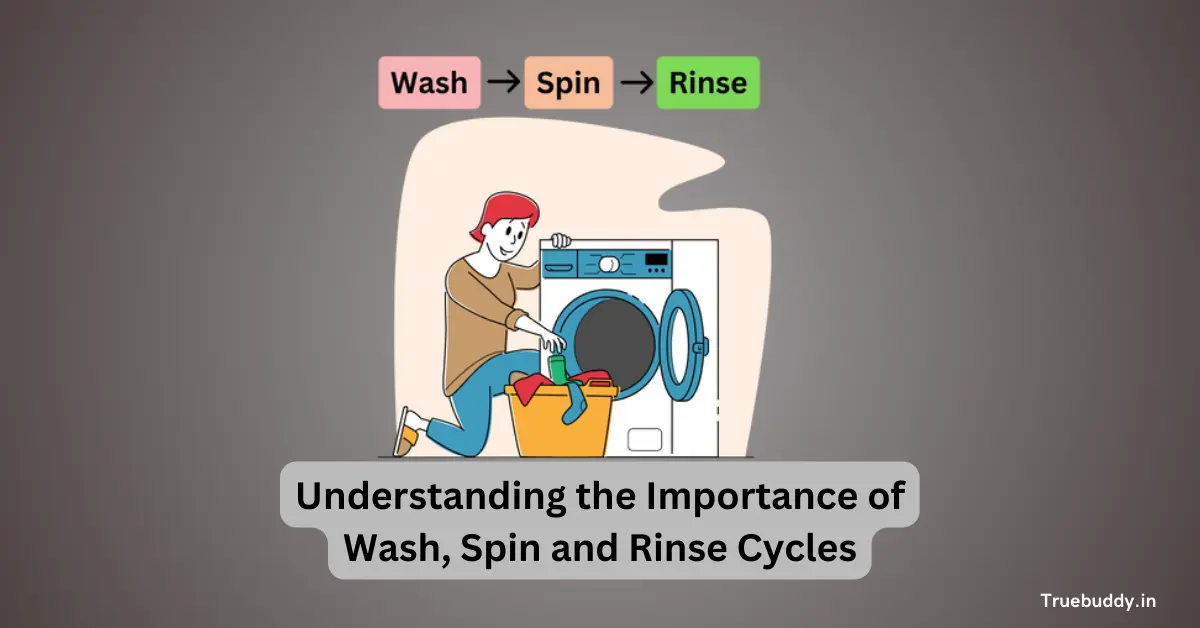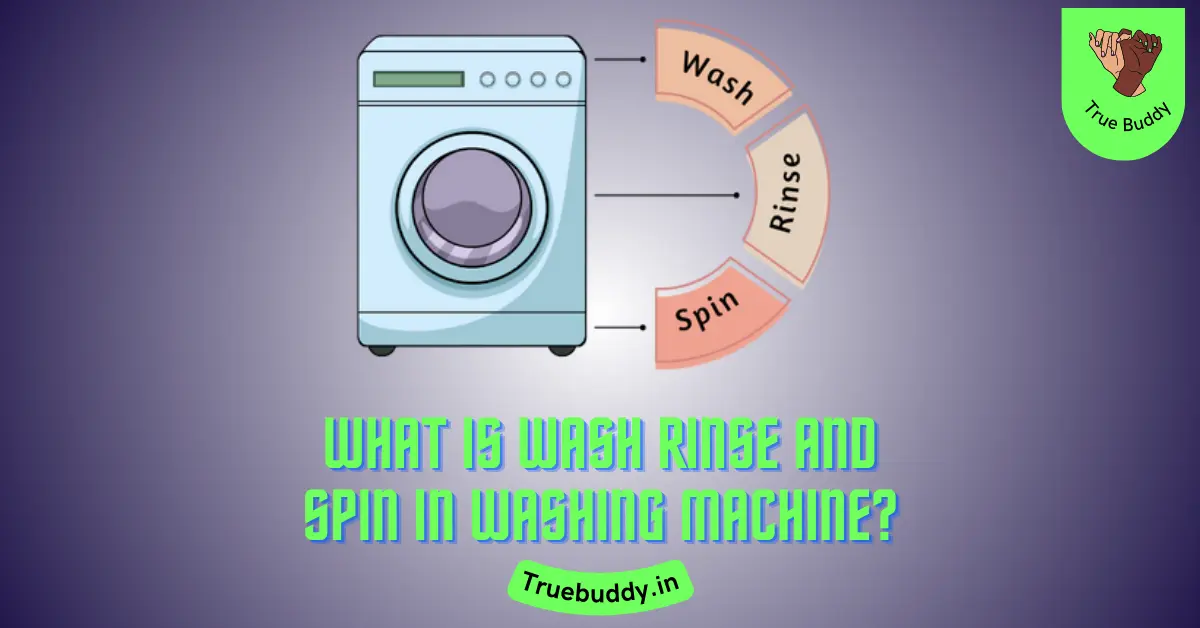Washing machines have become an essential home appliance, making the chore of laundry much more convenient. These machines perform various cycles to ensure thorough cleaning and proper care for your clothes. However, understanding the various intricacies of your washing machine is important to get the optimum result. The three most important functions of every washing machine are wash, rinse and spin cycle.
Through this article, we will delve into the intricacies of each cycle. We will also understand their purpose, and how they contribute to achieving clean and fresh laundry. So, let’s explore the wash, rinse and spin in washing machine.
You may also like:
- What is 4C Error in Samsung Washing Machine? Know How to Fix it.
- What is Rinse in Washing Machine: Know the Hidden Power
- What is Tumble Wash and How it Differs from Pulsator Wash or Impeller Wash?
- Top Load vs Front Load Detergent: Understanding the Difference
- What is the Soak Function in Washing Machine? – Explained

Wash Rinse and Spin in Washing Machine – Explained
1. The Wash Cycle: Cleaning Power at Work
The wash cycle is the heart of the washing machine operation. It involves the agitation of water, detergent, and clothes to remove dirt, stains, and odors from your garments. Here’s a breakdown of the wash cycle:
1.1 Filling the Drum
The first step is to fill the washing machine drum with water. The water level can be adjusted depending on the load size and desired water temperature. Hot water is suitable for whites and heavily soiled items, while cold water is gentler on delicate fabrics.
1.2 Adding Detergent
Once the drum is filled with sufficient water, it’s time to add the appropriate amount of detergent. The detergent helps break down dirt and stains, ensuring effective cleaning. Follow the detergent manufacturer’s instructions for the correct dosage.
1.3 Agitation
The washing machine’s agitator or impeller moves the clothes around vigorously, creating friction between the fabric fibers. This action helps dislodge dirt and stains from the clothes.
1.4 Soaking
In some washing machines, there is an optional soaking period before agitation begins. Soaking allows the detergent to penetrate the fabric, loosening tough stains and improving cleaning efficiency.
1.5 Draining
After the wash cycle is complete, the dirty water is drained from the drum, preparing the clothes for the rinse cycle.
2. The Rinse Cycle: Removing Detergent Residue
The rinse cycle is vital for removing detergent residue and ensuring that your clothes are thoroughly rinsed. It helps eliminate any remaining dirt particles and soap, leaving your garments clean and fresh. Here’s what happens during the rinse cycle:
2.1 Fresh Water Intake
The washing machine fills the drum with fresh water for rinsing purposes. Like in the wash cycle, you can adjust the water level and temperature.
2.2 Agitation
During the rinse cycle, the drum agitates the clothes again, but without detergent. This action helps to dislodge any remaining detergent particles from the fabric fibers.
2.3 Draining
Once the rinse cycle is complete, the water is drained from the drum, carrying away the detergent residue and loosened dirt particles.
2.4 Optional Additional Rinses
Some washing machines offer the option of additional rinse cycles. These extra rinses can be beneficial for individuals with sensitive skin or those who prefer minimal detergent residue on their clothes.
3. The Spin Cycle: Extracting Excess Water
The spin cycle is the final step in the washing process. It involves high-speed spinning of the drum to extract excess water from the clothes. Here’s all that you need to know about the spin cycle:
3.1 High-Speed Rotation
The washing machine spins the drum at a rapid speed, creating centrifugal force. This force pushes the water out of the clothes, helping them become significantly drier.
3.2 Adjustable Spin Speed
Many washing machines allow you to adjust the spin speed according to your preferences and the fabric type. Higher spin speeds remove more water but may be too harsh for delicate items, while lower speeds are suitable for sensitive fabrics.
3.3 Balanced Load
It’s crucial to ensure a balanced load during the spin cycle. Unevenly distributed clothes can cause the machine to vibrate excessively or even stop spinning. So, distribute the clothes evenly in the drum.
3.4 Post-Spin
Once the spin cycle is complete, you can remove the clothes from the washing machine. Depending on the remaining moisture level, you can hang the garments to air dry or transfer them to a dryer.
Understanding the Importance of Each Cycle (Wash Spin and Rinse)
Now that we have explored the wash, rinse and spin cycle in detail, it’s essential to understand the significance of each cycle:
The wash cycle removes dirt, stains, and odors from your clothes, thanks to the combination of water, detergent, and agitation.
The rinse cycle eliminates detergent residue, ensuring your clothes are free from any soap remnants that could cause skin irritation or stiffness.
The spin cycle extracts excess water, reducing drying time and allowing for efficient air drying or faster drying in a dryer.
By understanding these cycles, you can optimize your washing machine’s performance, achieve cleaner clothes, and prolong the lifespan of your garments.
Summary of Wash Spin and Rinse Cycle in Washing Machine
| Cycle | Purpose |
|---|---|
| Wash Cycle | Removes dirt, stains, and odors from clothes using a combination of water, detergent, and agitation. |
| Rinse Cycle | Eliminates detergent residue to ensure clothes are free from soap remnants that may cause skin irritation. |
| Spin Cycle | Extracts excess water, reducing drying time and allowing for efficient air drying or faster drying in a dryer. |
Conclusion
The wash, rinse and spin cycles are fundamental processes in any washing machine. They work together seamlessly to provide clean, fresh laundry. The wash cycle tackles dirt and stains, the rinse cycle removes detergent residue, and the spin cycle efficiently extracts excess water. Understanding how each cycle contributes to the overall washing process allows you to make the most of your washing machine’s capabilities.
Remember to follow the manufacturer’s instructions for loading capacity, water level, and detergent dosage to ensure optimal results. With this knowledge, you can confidently operate your washing machine and enjoy cleaner, fresher clothes every time you do laundry.
- Best Non-Stick Tawa for Easy Roti Making - October 5, 2024
- Best Towel Racks to Keep Your Bathroom Organized and Tidy - October 5, 2024
- Upgrade Your Bathroom with the Best Mirror Cabinets in India - October 5, 2024
